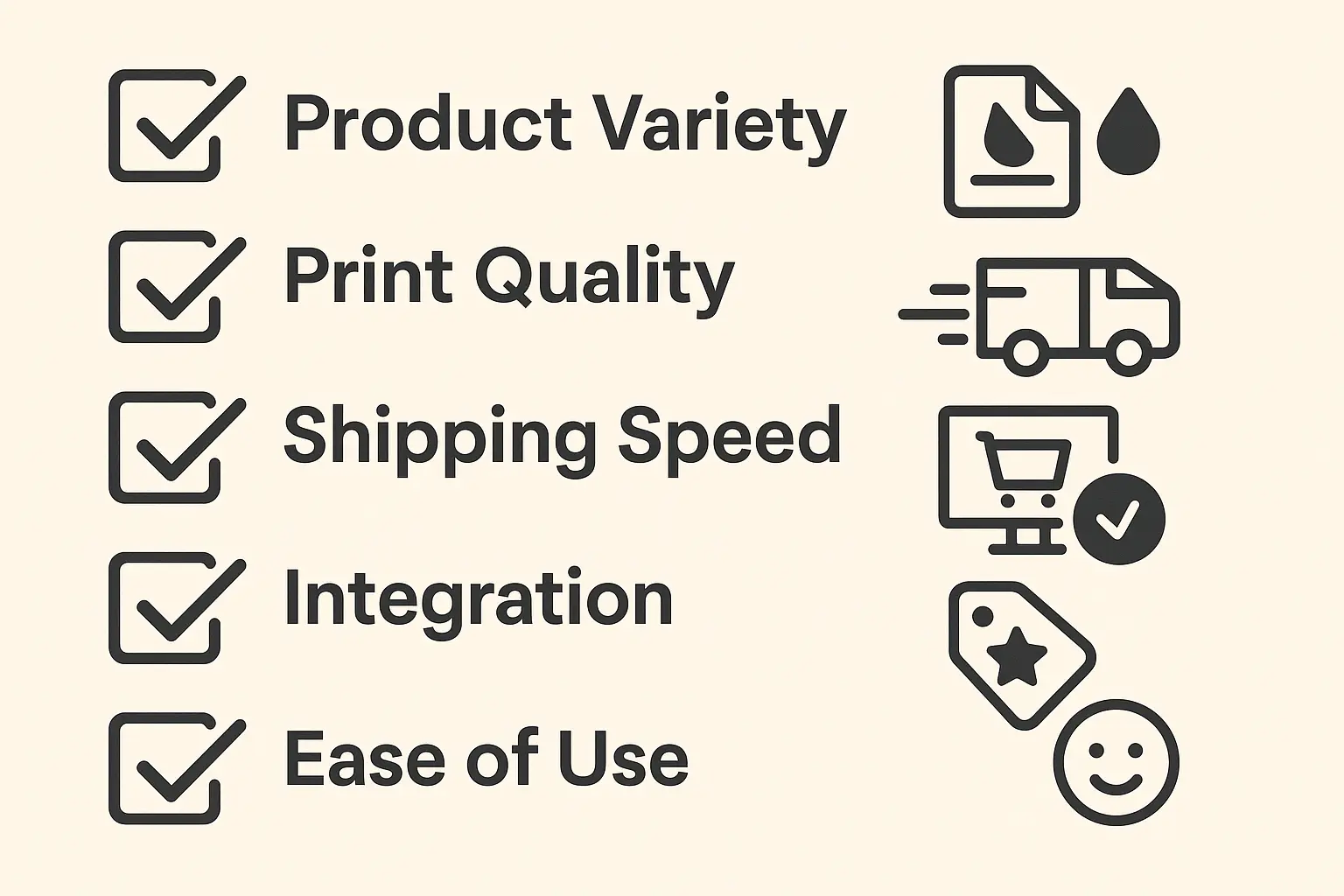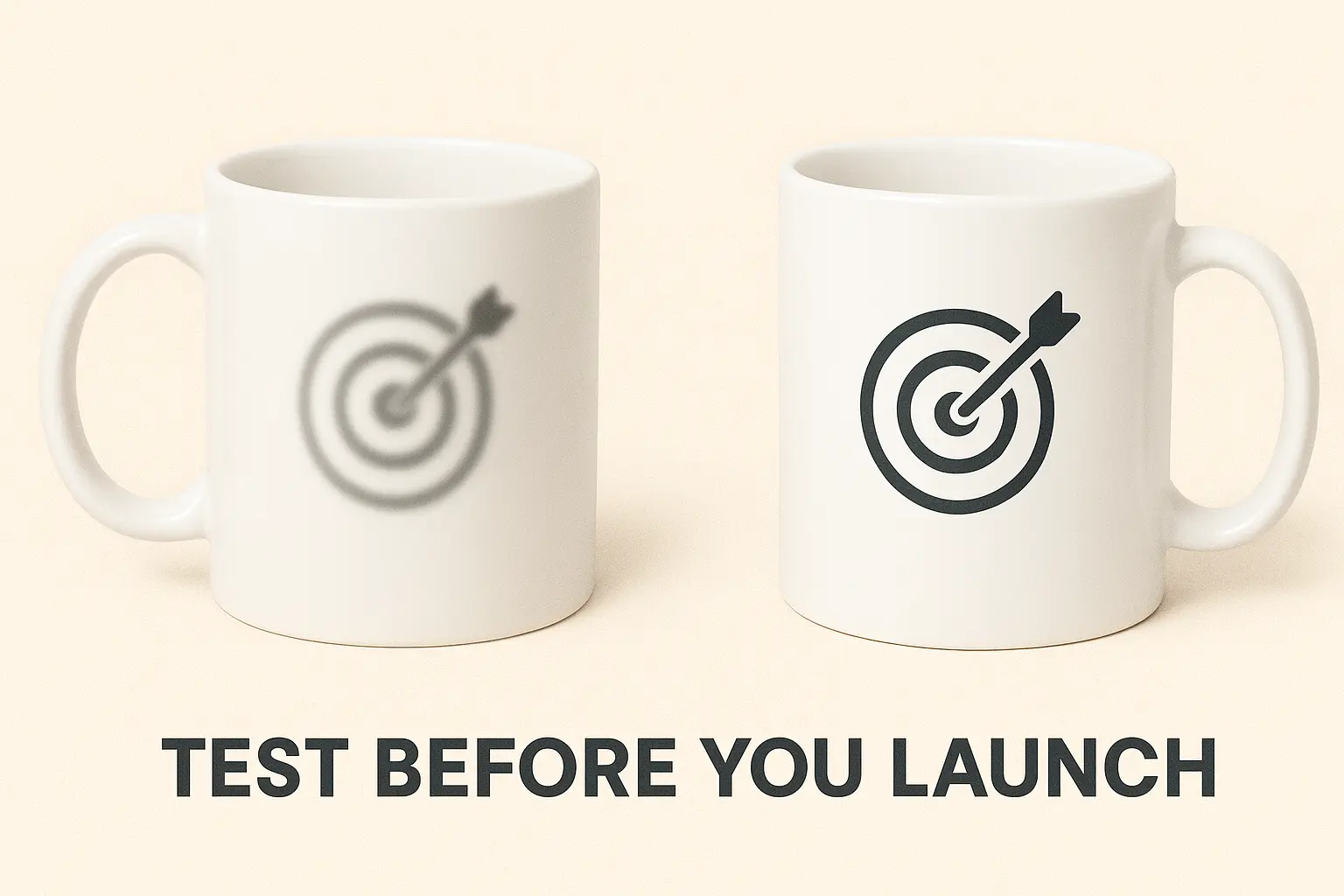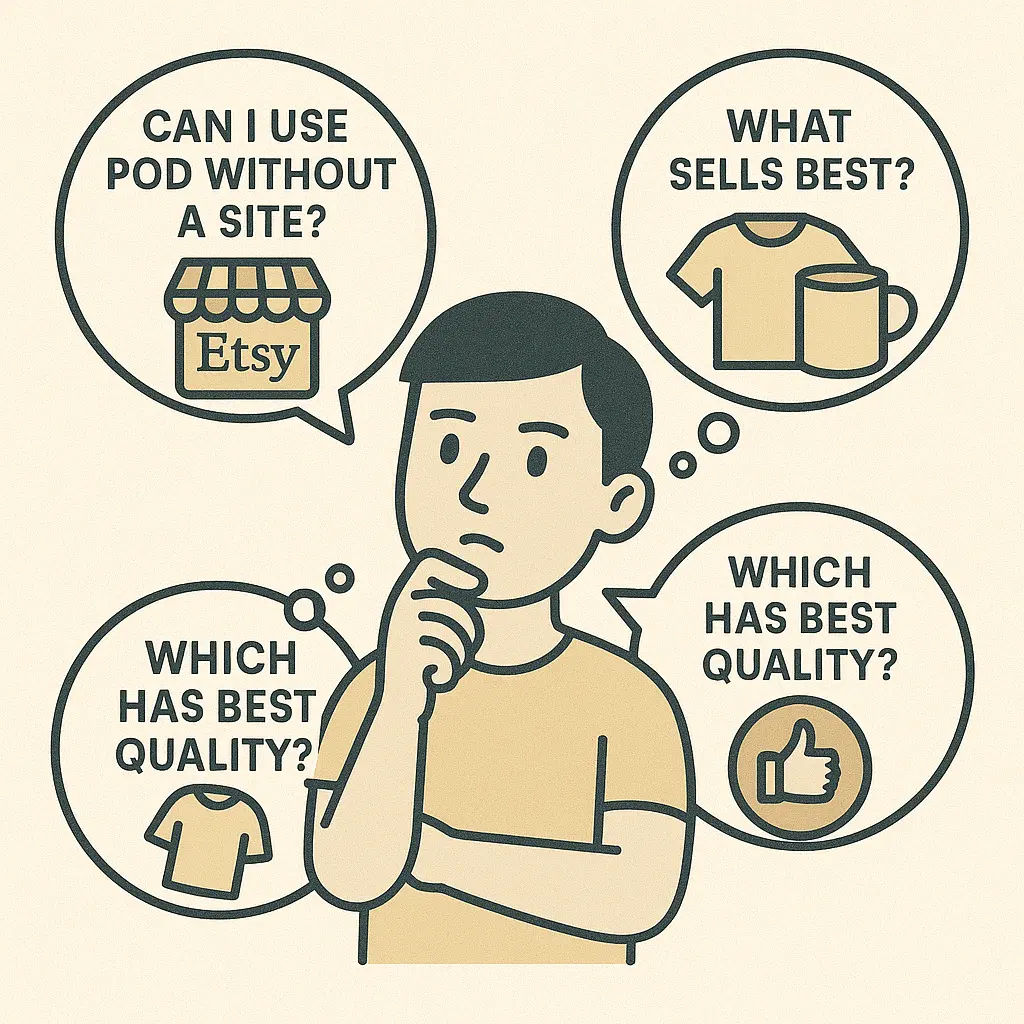What Is the Best Print-on-Demand Platform in 2025?

The best print-on-demand platform in 2025 is Shopify paired with Printful or Gelato. This setup lets you create and sell custom products online without holding inventory. Printing, packing, and shipping are handled for you — making it easy to run your store.
But not everyone has the same goal. Some people are just starting. Others want to grow fast or make more profit. So we put together a simple guide to help in choosing other best platform for your needs—no fluff, just the facts.
Key Takeaways:
- Print-on-demand is beginner-friendly. You don’t need to manage inventory or shipping — just upload your designs and start selling.
- Different platforms serve different needs:
- Printify offers the most product options and flexible pricing.
- Printful focuses on strong branding tools and premium quality.
- Fourthwall is ideal for creators with a built-in fanbase.
- Zendrop excels at fast shipping, especially within the U.S.
- Lulu xPress is best for books and other print media.
- Success comes from testing and smart strategy. Start small, price your products carefully, and invest in marketing. There’s real profit potential — but no shortcuts.
What Is Print-on-Demand?
Print-on-demand (POD) is a way to sell custom products online without holding inventory. When a customer places an order, a POD company prints the product and ships it directly to them.
Here’s how it works:
- You upload your design to a product, like a t-shirt, mug, or notebook.
- When someone buys it, your POD partner handles printing, packing, and delivery.
- You earn a profit without ever touching the product.
POD is beginner-friendly because it’s low-risk, affordable, and easy to set up. It works well with ecommerce platforms like Shopify, Etsy, and Amazon.
Want to explore more ways to sell online without managing inventory? Check out our guide: How to Sell on Amazon Without Inventory.
What Are the Benefits of Using a Print-on-Demand Platform?

Print-on-demand platforms make it easy to start an online business without inventory, upfront costs, or shipping hassles. They’re ideal for beginners and anyone looking for a low-risk ecommerce model.
Here are the key benefits:
- No upfront inventory costs – You only pay for products after a customer places an order.
- Simple store setup – Most POD platforms integrate with Shopify, Etsy, and other ecommerce sites.
- Wide product variety – Sell custom items like t-shirts, mugs, journals, phone cases, and more.
- Scalable business model – Add new products anytime and grow your income, even passively.
What are the Key Factors to Consider When Choosing a POD Platform?

When choosing a print-on-demand (POD) platform, it’s important to look at product variety, print quality, shipping speed, pricing, and store integration. These factors affect your profit margins and your customer’s experience.
Here are the most important things to consider:
- Product variety: More product types give you more flexibility to target your niche. Some platforms focus on apparel, while others offer books, home decor, or pet products.
- Print quality and shipping speed: A strong design won’t help if the print fades or arrives late. Read customer reviews and order samples to check quality and delivery times.
- Pricing and profit margins: Compare base prices, shipping costs, and seller fees. Look at how much profit you’ll make per sale.
- Store integration: Make sure the platform connects easily with your ecommerce store, such as Shopify, Etsy, or WooCommerce.
👉 Check our guide to the best ecommerce platforms for 2025. - Branding options: Some POD providers let you add custom labels, packaging, or thank-you notes — great for building brand loyalty.
- Ease of use and support: Choose a platform with an intuitive dashboard, helpful tutorials, and fast customer service — especially if you’re a beginner.
What Are the Best Print-on-Demand Platforms in 2025?

The best print-on-demand (POD) platforms in 2025 are Printify, Printful, Zendrop, Fourthwall, and Lulu xPress. Each one offers unique features depending on your niche, business model, and branding needs.
Here’s a breakdown:
1. Printify
- Product variety: Over 1,300 items, including apparel, socks, yoga mats, and accessories
- Print providers: 90+ global partners
- Print methods: DTG, DTF, embroidery, sublimation, and more
- Pricing: Free plan available; Premium plan offers better margins
- Best for: Sellers who want flexibility and control over profit margins
- Watch out for: Print quality may vary by provider
2. Printful
- Product focus: High-quality printing with professional finishes
- Shipping: Fast global delivery; optional warehousing
- Branding: Offers custom labels, packaging inserts, and branding tools
- Best for: Creators who want premium products and a polished brand
- Note: Higher base costs may reduce profit margins
3. Zendrop
- Model: POD and dropshipping hybrid
- Fulfillment: U.S.-based warehouses with fast shipping
- Customization: Offers branded packaging and automation tools
- Best for: Beginners who want an easy setup with strong support
4. Fourthwall
- Target users: Content creators, artists, and influencers
- Products: Sell merch, digital downloads, and memberships
- Integrations: Works with YouTube, TikTok Shops, and other platforms
- Best for: Monetizing your audience with both physical and digital products
5. Lulu xPress
- Product focus: Books, comics, magazines, and print media
- Tools: Self-publishing platform with layout support
- Best for: Writers and creatives who want to sell printed publications
How Do You Choose the Right Print-on-Demand Platform?

To choose the best print-on-demand (POD) platform, match it to your niche, product type, pricing needs, and ecommerce setup. There’s no one-size-fits-all — the right choice depends on your business goals.
Here’s how to make the right choice:
1. Define your niche and product focus
Are you selling pet-themed t-shirts, art prints, or custom journals? Choose a platform that offers the products and features your target audience wants.
👉Check out our comprehensive guide to determine the best niche for POD.
2. Compare pricing and shipping costs
Review base product prices, shipping fees, and delivery times in your key markets. A simple spreadsheet can help you spot profit-friendly options.
3. Order product samples to check quality
Always test before you commit. Poor print quality or uncomfortable materials can hurt your reviews and increase returns.
4. Consider branding and customization features
If you want to add custom labels, packaging, or thank-you notes, make sure the platform supports those options.
5. Check ecommerce integrations
Your POD platform should connect smoothly with your store—whether it's Shopify, Etsy, WooCommerce, or another ecommerce tool.
Tip: Don’t just pick the cheapest option. Low upfront costs can sometimes lead to poor support or slim margins down the road.
How Do You Get Started With Your First Print-on-Demand Store?
To start a print-on-demand store, choose a POD platform, connect it to your ecommerce site, design a few products, set pricing, and launch. It’s beginner-friendly and doesn’t require inventory or upfront product costs.
Here’s a step-by-step guide:
1. Pick the right POD platform
Use the comparison above to choose a provider that fits your niche, product type, and budget.
2. Sign up and connect your ecommerce store
Most platforms integrate with Shopify, Etsy, or WooCommerce. Connect them so orders flow automatically.
3. Design your first products
Start small—one or two designs are enough to test. Choose products your audience will love.
👉 Need ideas? Check our list of trending POD products for 2025.
4. Set your pricing and shipping options
Make sure you leave room for profit. Consider product base costs, shipping fees, and marketing spend.
5. Launch your store and start marketing
Promote your store on social media, email newsletters, and through micro-influencers.
👉 Want a full launch plan? Read our ecommerce startup guide.
What Are Common Mistakes to Avoid as a Print-on-Demand Beginner?
Common mistakes that beginners make include skipping product samples, underpricing items, launching with too many products, and ignoring branding. Avoiding these can help you start stronger and waste less time.
Top print-on-demand mistakes to avoid:
- Skipping product samples
Never list products you haven’t tested. Always order samples to check print quality, fit, and shipping time. - Underpricing your products
Low prices might attract clicks, but they can wipe out your profit. Factor in base costs, shipping, and ad spend before setting your prices. - Launching with too many products
Focus on 1–3 products to start. Too many options can overwhelm buyers and make store setup harder. - Ignoring branding
A consistent brand — from your logo to product photos — helps build trust and stand out. Even if it’s a side hustle, take branding seriously. - Expecting instant results
Print-on-demand takes time to grow. Don’t quit too early. Keep testing designs and improving your store based on feedback.
Frequently Asked Questions

1. What is the cheapest print-on-demand service to start with?
The cheapest services are Printify and Lulu xPress. Both let you start for free with no setup cost.
2. Can I use print-on-demand without a website?
Yes. You can sell on Etsy, Fourthwall, or TikTok Shop without your own website.
3. Which print-on-demand platform has the best quality?
Printful has the best quality. It offers sharp prints and nice packaging.
4. Is print-on-demand still profitable in 2025?
Yes, it is. You can still make money if you choose the right products and promote them well.
5. What products sell best with print-on-demand?
Best-sellers include t-shirts, hoodies, mugs, phone cases, and notebooks.
6. Can I use more than one print-on-demand platform?
Yes. Many sellers use two or more to get better prices and faster shipping.
7. Do I need to be a designer to start print-on-demand?
No. You can use tools like Canva, buy designs, or hire someone to help.
8. How long does it take to get your first sale?
It can take a few days or a few weeks. It depends on your designs and how you market them.
9. Which platforms work best with Etsy?
Printify, Printful, and Fourthwall work well with Etsy and connect easily.
10. How do returns and customer service work?
Most platforms handle returns for broken items. You answer messages and help your customers.
Final Thoughts: What’s the Best Print-on-Demand Platform for You?
The best print-on-demand platform depends on what you need. Do you want more products to sell? Fast shipping? Cool designs? There’s a good option for everyone.
Here’s a quick list to help you choose:
- Printify – Great if you want lots of products and control over prices
- Printful – Best if you want high-quality prints and custom packaging
- Fourthwall – Made for creators who sell merch and digital stuff
- Zendrop – Good for beginners who want help and fast shipping
- Lulu xPress – Best for selling books, magazines, or journals
Print-on-demand is still a smart way to start a business in 2025. Keep it simple. Try a few things. Learn what works—and grow from there.
Want to Start a Print-on-Demand Store That Actually Sells?
Join our mini-course at WAH Academy and get real tips on picking the right platform, pricing your products, and making sales—not just setting up shop.
No fees. No fluff. Just straight-up guidance from people who’ve been there.
Tap the button and let’s get your POD business off the ground.
